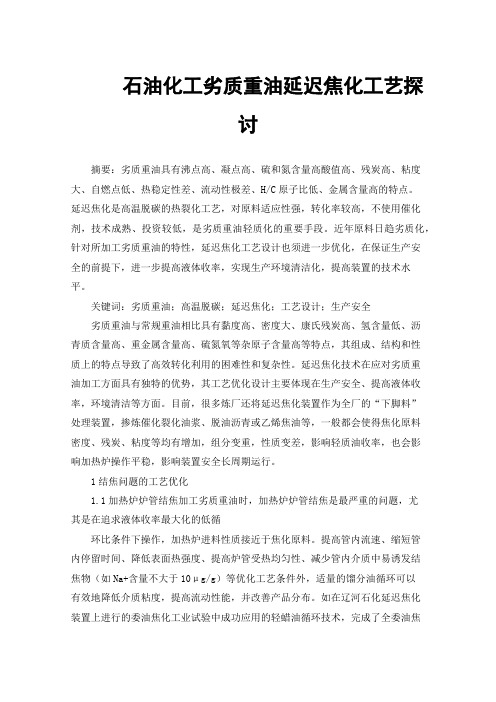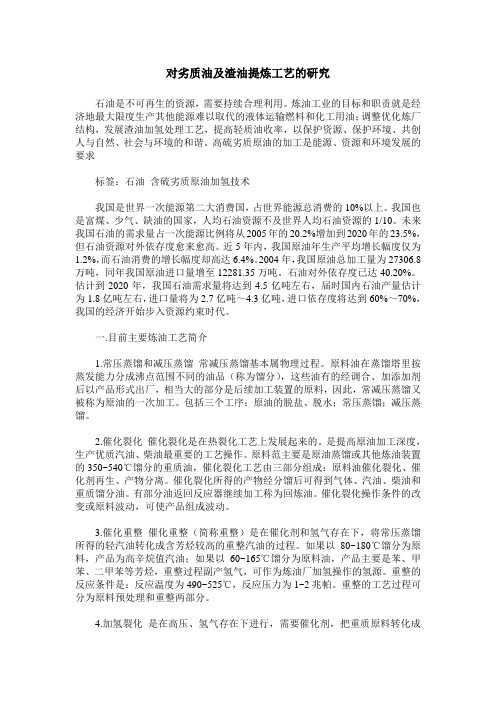第八讲劣质重油深加工工艺资料
第八讲 劣质重油深加工工艺解析

√
√
√
√
√
<25
<7
<0.5
×
√
√ √
√
√&? ×
√
√ √
√
√ √
<70
70~200 200~800
<15
<15
★
×
?
>800
4、脱碳工艺对重油原料的适应性强
5、渣油深加工发展趋势 • 美国自1994年起, 减压渣油的深加工基本上围绕 延迟焦化配套相应精制系统(“Since 1994, all residue upgrading in the USA has been based on delayed coking”).
Delayed Coking-Advances
Total capacity of delayed coking units amounting to
32%; residue processing capacity reached to 0.3
billion t/a in the world and 90 million t/a in China.
More residues are processed in US refineries.
during the past 10 years:
3、重油加工技术的选择(示意图)
20
理
重油催化
加氢处 理
热 加 工
200
0
10
100 Ni+V ppm
3、重油加工技术的选择
重油深加工工艺
RFCC 焦化 固定 床 沸腾 床 悬浮 床
渣油原料性质
Ni+V,PPm 残碳, m% 硫,m% 难度 易加工 不难 稍难 难加工 极难
石油化工劣质重油延迟焦化工艺探讨

石油化工劣质重油延迟焦化工艺探讨摘要:劣质重油具有沸点高、凝点高、硫和氮含量高酸值高、残炭高、粘度大、自燃点低、热稳定性差、流动性极差、H/C原子比低、金属含量高的特点。
延迟焦化是高温脱碳的热裂化工艺,对原料适应性强,转化率较高,不使用催化剂,技术成熟、投资较低,是劣质重油轻质化的重要手段。
近年原料日趋劣质化,针对所加工劣质重油的特性,延迟焦化工艺设计也须进一步优化,在保证生产安全的前提下,进一步提高液体收率,实现生产环境清洁化,提高装置的技术水平。
关键词:劣质重油;高温脱碳;延迟焦化;工艺设计;生产安全劣质重油与常规重油相比具有黏度高、密度大、康氏残炭高、氢含量低、沥青质含量高、重金属含量高、硫氮氧等杂原子含量高等特点,其组成、结构和性质上的特点导致了高效转化利用的困难性和复杂性。
延迟焦化技术在应对劣质重油加工方面具有独特的优势,其工艺优化设计主要体现在生产安全、提高液体收率,环境清洁等方面。
目前,很多炼厂还将延迟焦化装置作为全厂的“下脚料”处理装置,掺炼催化裂化油浆、脱油沥青或乙烯焦油等,一般都会使得焦化原料密度、残炭、粘度等均有增加,组分变重,性质变差,影响轻质油收率,也会影响加热炉操作平稳,影响装置安全长周期运行。
1结焦问题的工艺优化1.1加热炉炉管结焦加工劣质重油时,加热炉炉管结焦是最严重的问题,尤其是在追求液体收率最大化的低循环比条件下操作,加热炉进料性质接近于焦化原料。
提高管内流速、缩短管内停留时间、降低表面热强度、提高炉管受热均匀性、减少管内介质中易诱发结焦物(如Na+含量不大于10μg/g)等优化工艺条件外,适量的馏分油循环可以有效地降低介质粘度,提高流动性能,并改善产品分布。
如在辽河石化延迟焦化装置上进行的委油焦化工业试验中成功应用的轻蜡油循环技术,完成了全委油焦化总循环比0.1的操作。
1.2分馏塔高温段结焦对劣质重油来说,其结焦温度低,与反应油气塔内直接接触换热容易引起脱过热段结焦,较常规渣油更加突出。
劣质重油流化催化热接触加工技术

化工 化学 原料
柴油
航煤
物理
汽油
一.技术背景
重油加氢轻质化技术
悬浮床加氢技术
处于工业试验阶段; 工程放大存在诸多难题。 沸腾床加氢技术
固定床加氢技术
催化剂耗量高达2 kg/吨油 转化率仅为60 % 加氢尾油富含胶质和重芳烃 ,只能做燃料油。
原料Ni+V不可高于150 µg/g; 原料残炭不大于16 wt%
根据测试,FTC™技术加工每吨劣质重油比延迟焦化增加 159元效益,以每年150万吨计,可以增加利润2.38亿。
延迟焦化
项目
产物分布 单价 /wt% (元/t)
干气
6.50
2260
液化气
1.54
4457
汽油
10.65
6053
柴油
45.52
4943
重油
11.43
2820
焦炭
23.95
850
损失
0.41
三.应用效果
4.产物组成
干气,wt%
项目
数据
氢气
5.45
甲烷
31.30
乙烷
27.62
乙烯
35.63
合计
100
表3 气体产物组成
液化气,wt%
项目
数据
项目
数据
丙烷
1.18
异丁烯
丁烯
7.59
异丁烷
11.30
丁二烯
0.44
正丁烷
2.90
乙炔
1.11
顺-2-丁烯
10.81
项目
密度,kg/m3 残炭值,wt% 重金属含量, g/g 硫含量,wt% 沥青质含量,wt%
重劣质原油深加工技术

重劣质原油深加工技术随着常规原油资源的日益枯竭,世界原油供应呈现出重质化、劣质化的发展趋势,从资源可获取性、吨原油经济效益、装置的适应性等方面考虑,对进口原油整体依存度高达60%以上的中国炼油企业而言,重视重质、劣质原油加工是炼油工艺的重要技术问题。
“十三五”期间,国家政策将继续引导炼油产业升级,加快结构调整、向民企开放下游。
同时我国炼油行业也面临着环保日益严格、清洁燃料标准不断提高的压力,在此大背景下中国石油和石化工程研究会定于2017年4月12日至14日在洛阳召开“第六届(2017)炼油技术暨重劣质原油深加工技术与装备供需交流会”,促进炼油(炼化)企业同科研、设计、装备制造单位和有关产业之间的技术交流与合作。
含硫含酸原油分类及问题硫含量、酸性对原油的一般分类加工高硫原油与加工高酸原油最大的问题是腐蚀,两者带来的腐蚀问题是又不同的。
加工高酸原油带来的腐蚀问题主要集中在蒸馏装置,而加工高硫原油时,由于原油中的非活性硫不断向活性硫转变,使硫腐蚀不仅存在于一次加工装置,也同样存在于二次加工装置,甚至延伸到下游化工装置,贯穿于炼油的全过程中。
硫在原油的不同馏分中的含量和存在的形式不尽相同,但都随沸点的升高而增加,并且富集于渣油中。
含酸及高酸原油的加工高酸原油组成结构含酸原油的腐蚀及一般规律含酸原油的加工,通常有以下几种:1、与低酸值原油混炼,混合后控制酸值≯0.5mgKOH/g。
2、与低酸值原油交替加工,在加工低酸值原油时,高温部位可能产生保护膜或薄层焦,减腐蚀。
3、材质升级:在t>220°℃时,用316L及以上材质。
对大口径管道,采用不锈钢复合板制成的钢管。
对可预见严重冲刷部位,采用大曲率半径的弯头及斜接分支三通。
在材质升级的同时,优化、开好电脱盐。
4、注NaOH中和。
但因为Na+升高,给重油催化、焦化及加氧装置带来不利影响,不是根本方法,只能应急5、脱酸处理彻底解决腐蚀问题,必须进行脱酸处理,目前脱酸处理方式主要包括碱法脱酸、酯化脱酸、催化热解脱酸、催化加氢脱酸(固定床)、催化脱羧裂化技术等。
燃料油(重油)深加工工艺概述

4、减压深拔加工工艺
减压深拔加工工艺装置是目前我国通用的 重油加工工艺,该装置的原料主要由催化油浆 及燃料油组成,减压深拔过程是原料油在220~ 260摄氏度和5~20帕的压力条件下,通过降低 油气分压,将轻重组分进行分离,轻重组分分 别经过换热和冷凝最终得到混合芳烃和重芳烃 的过程。其产品产率分布及特点如下表:
<60
<40 <160
--
--
备注 乙烯含量高 丙烯含量高 辛烷值低、安定性差
金属含量较高 --
催化裂解工艺(DCC)气相收率较高,其燃料气中 乙烯含量在22~28%,液化气中丙烯含量达30%以上,均可 进一步进行气体分离;裂解汽油辛烷值较低,安定性也较 差;中间馏分油和重油芳烃含量较少只能用来调和燃料油。
催化油浆 5~15
焦碳
5~7
>65 --
>120 --
粘度较大 --
催化裂化工艺(FCC)生产的液化气中丙烯含量较高,可进一步 进行气体分离;催化汽油辛烷值RON约85~93,安定性也较好;催 化柴油十六烷值较低,安定性较差,一般经过加氢精制后才能符合 国标柴油指标;催化油浆沥青质含量较低,富含多环芳烃,是橡胶 和塑料加工用芳烃油的良好原料。
重油催化裂化工艺流程图
烟机
反
再生器
应 器
取 热 器
主风 原料
分馏 系统
稳定 系统
液化气 汽油
柴油去加氢精制
燃料油 (油浆)
产品名称 收率% 芳烃含量% 闪点℃
备注
液化气 10~20
--
--
丙烯含量高
催化汽油 30~60 40~45
<25 辛烷值高、安定性较好
催化柴油 20~40
<50
<50 十六烷值低、安定性较差
重质油加氢

不回收,(也可循环使用,排出部分催化剂), 因此无需考虑由于催化剂中毒、堵塞带来的问 题。这种工艺大都采用空筒式反应器,具有良 好的发展前景。
? 目前加拿大 AOSTRA开发的(HC) 3工艺(高 转化率、均相催化和加氢裂化三句的缩写)是 一种悬浮床加氢裂化与固定床加氢精制相结合 的工艺。该工艺除了具有上述悬浮床特点外, 其反应压力( 11~14MPa )明显降低。同时由
第八讲 重质油加氢
概况:重油加工除脱碳外可走加氢的
道路 由于投资及成本(氢耗)较高,加氢占 重油加工的6% 。 我国不必走科威特多巴炼厂全加氢流程, 但加氢也要适当发展。
1983 年世界第十一届石油会议资料:
重油加氢中热加工 83%(其中:
焦化占 71% ,减粘占 12% )
重油催化裂化 6%
脱碳94%
? 渣油加氢工艺较多,目前首选的主要是固 定床和悬浮床(浆液床)加氢工艺。固定床加 氢在处理渣油加氢时,由于催化剂易受堵塞和 中毒,寿命较短,所以该技术一般更适合于加 工金属含量、杂质和粘度不太高的含硫渣油, 而且该技术还存在着空速低(固定床在处理渣 油是空速约为悬浮床的 1/3),渣油转化率低 (一般 <50% ),开工周期短,催化剂装卸难,
? 该工艺是借助于液体流速将一定颗粒度的催化剂 自下而上带动呈一定界面,使氢气、催化剂和原 料充分接触而完成加氢反应过程。反应器内的液 体与催化剂呈返混状态流动,反应产物与气体自 上部逸出。运转期间催化剂可定期自反应器顶部 加入,下部排出,以维持较高活性。
? 该工艺的特点是:
? (1)可处理高金属、高残碳的劣质渣油
以及投资和操作费用高等问题。针对固定床加 氢工艺,该工艺对处理劣质原油(高金属、高 粘度、高残碳的稠油)特别有效。
对劣质油及渣油提炼工艺的研究

对劣质油及渣油提炼工艺的研究石油是不可再生的资源,需要持续合理利用。
炼油工业的目标和职责就是经济地最大限度生产其他能源难以取代的液体运输燃料和化工用油;调整优化炼厂结构,发展渣油加氢处理工艺,提高轻质油收率,以保护资源、保护环境、共创人与自然、社会与环境的和谐。
高硫劣质原油的加工是能源、资源和环境发展的要求标签:石油含硫劣质原油加氢技术我国是世界一次能源第二大消费国,占世界能源总消费的10%以上。
我国也是富煤、少气、缺油的国家,人均石油资源不及世界人均石油资源的1/10。
未来我国石油的需求量占一次能源比例将从2005年的20.2%增加到2020年的23.5%,但石油资源对外依存度愈来愈高。
近5年内,我国原油年生产平均增长幅度仅为1.2%,而石油消费的增长幅度却高达6.4%。
2004年,我国原油总加工量为27306.8万吨,同年我国原油进口量增至12281.35万吨。
石油对外依存度已达40.20%。
估计到2020年,我国石油需求量将达到4.5亿吨左右,届时国内石油产量估计为1.8亿吨左右,进口量将为2.7亿吨~4.3亿吨,进口依存度将达到60%~70%,我国的经济开始步入资源约束时代。
一.目前主要炼油工艺简介1.常压蒸馏和减压蒸馏常减压蒸馏基本属物理过程。
原料油在蒸馏塔里按蒸发能力分成沸点范围不同的油品(称为馏分),这些油有的经调合、加添加剂后以产品形式出厂,相当大的部分是后续加工装置的原料,因此,常减压蒸馏又被称为原油的一次加工。
包括三个工序:原油的脱盐、脱水;常压蒸馏;减压蒸馏。
2.催化裂化催化裂化是在热裂化工艺上发展起来的。
是提高原油加工深度,生产优质汽油、柴油最重要的工艺操作。
原料范主要是原油蒸馏或其他炼油装置的350~540℃馏分的重质油,催化裂化工艺由三部分组成:原料油催化裂化、催化剂再生、产物分离。
催化裂化所得的产物经分馏后可得到气体、汽油、柴油和重质馏分油。
有部分油返回反应器继续加工称为回炼油。
劣质重油深加工工艺资料课件

THE FIRST LESSON OF THE SCHOOL YEAR
• 劣质重油概述
• 深加工工艺的挑战与解决方案 • 劣质重油深加工的发展趋势与展望
01
劣质重油概述
定义与特性
定义
劣质重油是指残炭值、粘度、闪点等 关键指标较低的石油产品,通常指低 品质的燃料油。
02
03
脱氮
脱氧
降低油品中氮含量,提高油品质 量。
降低油品中氧含量,提高油品安 定性。
01
深加工产品及应用
轻质油品
轻质油品是从重油中提炼出的较轻的油品,如汽油、煤油和柴
01
油等。
02
轻质油品具有较高的能量密度和挥发性,常用于燃料和溶剂等
领域。
在劣质重油深加工过程中,轻质油品是重要的副产品,其质量
03
和产量对整个加工工艺的效益和效率具有重要影响。
柴油
柴油是从重油中提炼出的较轻的油品之一,具有较高的能量密度和较好的燃烧性能。
柴油广泛用于交通运输、工业生产和发电等领域,是现代社会不可或缺的能源之一。
在劣质重油深加工过程中,柴油是重要的产品之一,其质量和产量对整个加工工艺 的经济效益具有重要影响。
为了提高劣质重油的附加值和竞争力,需要不断开发高附 加值的产品和应用领域。
研究方向包括高附加值润滑油、特种燃料、高分子材料等 方面的开发和应用。通过多元化的发展,可以满足不同领 域的需求,提高劣质重油的经济效益和社会效益。
THANKS
THE FIRST LESSON OF THE SCHOOL YEAR
特性
劣质重油具有高粘度、高残炭、低热 值等特点,不易流动和雾化,燃烧不 稳定。
劣质重油加工新技术-中国石油天然气集团

求,满足委内瑞拉超重油长期输送的技术要求。 术、生产重交沥青技术和生产环保型橡胶填充
油技术。中国石油针对目前世界最劣质的原油,
开发出了一套成熟可靠的技术方案。
6
劣质重油加工新技术
2.2.1 劣质重油渣油延迟焦化技术 延迟焦化工艺是一种重油深度热转化工艺,具有
原料适应性强、转化深度高、投资费用低等特点,并 且其产品焦化汽油经过加氢后是较好制乙烯的原料 ; 焦化柴油具有较高的十六烷值 ;焦化干气和富气是制 氢的好原料。焦化工艺优势明显,已成为重质油改质 和零排放首选工艺之一。 技术特点
a PAHA 罐+ CAST 池 c SAHA 池
b CAST 池 d BAF 池
10
劣质重油加工新技术
2.3.1 劣质重油脱盐脱钙加工技术
● 优化了再生反应器设计参数,使间歇式
操作优化为连续式操作,提高了装置的自动化 在原油加工过程中,有机钙盐分解成钙沉
程度。装置运行平稳。 淀物而影响生产,钠盐对装置腐蚀作用很强。
适用于委内瑞拉井口油的改质降黏加工, 技术特点
降低原油黏度,改质油达到长期储存稳定性要 求,满足委内瑞拉超重油长期输送的技术要求。
● 优化了减黏裂化工艺参数。
● 委内瑞拉大于 350℃ 常压渣油,经过减
黏裂化和调和后,改质油 50℃ 运动黏度能控 制在 200mm2/s 左右,API 度达到 11 〜 12,稳
反应器入口温度(℃) 生成油主要性质 黏度(50℃)(mm2/s) 稳定性(S 值) 斑点试验,级 甲苯不容物(m%) 改质油主要性质 黏度(50℃)(mm2/s) 稳定性(S 值) 斑点试验,级 甲苯不容物(m%)
420
2191 2.0 Ⅰ 0.01
132.5 0.1 Ⅰ 0.007
重质油加工工艺综述PPT课件

13/70
第13页/共71页
三. 重质油加工工艺的现状
2. 加氢裂化 • 加氢裂化工艺的特点是产品灵活性大,产品质量好,在炼厂装置组成中占有重要地位,可以起到根据市场
变化调节产品种类的作用。其生产的石脑油可作为 • 汽油组份或作为催化重整原料生产BTX芳烃 • 可以生产喷气燃料和低硫柴油 • 可以生产BMCI值低的尾油作乙烯裂解原料或润滑油原料
• 加氢裂化技术渊源于上世纪30年代在德国应用的煤焦油加氢裂化,由于其操作条件苛刻(压力22.0MPa, 温度400~420℃,室速0.64h-1)在二战后没有继续应用。
14/70
第14页/共71页
三. 重质油加工工艺的现状 • 直到上世纪60年代,对汽油的需求增长很快,而当时催化裂化的转化率低,
加氢裂化工艺过程分类 加氢裂化工艺过程
单段(反应器间不进行产品分离)
两段(一段和二段间进行产品分离)
只有一个HC反应器
• 单一催化剂 • 低硫低氮原料
HT+HC 一个或两个反应器
• 两种催化剂 • 高硫高氮原料
HT+HC (两个反应器)
• 两种催化剂 • HT段产品进行分离 • 尾油循环至HC反应器
• 在FCC工艺方面,我国已开发出DCC、MIP、MGG、FDFCC、 TSRFCC等新技术。有的技术如DCC已出口到国外;
• 在催化剂方面我国已开发出REY、USY、REHY、ZRP等沸石系列FCC 催化剂,有的已向国外出口。
• 在催化剂烧焦再生方面也开发了单器再生、双器两段再生、快速床再 生(烧焦罐)、重叠式再生等多种型式。
• 贵金属组分则以Pt、Pd为主,多以金属状态使用
• 在以生产中间馏分为主的加氢裂化催化剂,普遍采用Mo-Ni或Mo-Co, 以生产润滑油料为主时则采用W-Ni
- 1、下载文档前请自行甄别文档内容的完整性,平台不提供额外的编辑、内容补充、找答案等附加服务。
- 2、"仅部分预览"的文档,不可在线预览部分如存在完整性等问题,可反馈申请退款(可完整预览的文档不适用该条件!)。
- 3、如文档侵犯您的权益,请联系客服反馈,我们会尽快为您处理(人工客服工作时间:9:00-18:30)。
H-Oil
415~440 13.5~21.0
— 0.4~1.3 0.35~2.1
45~85 65~82 25~45 45~75 65~90 130~300
LC-Fining
410~440 11.0~18.0 7.5~12.5
55~80 60~85
40~70 65~88 135~300
High temperature: operation temperature is almost the same with end-of-run temperature of fixed bed residue hydrogenation High pressure: To stabilize operation, maintain hydrogen partial pressure at outlet of reactor. High hydrogen consumption: For VR converted and contaminates removal.
建造与操作费用很高 • 我国重整原料和烯烃裂解原料不足 • 我国加氢的氢源不足(石脑油制氢) • 提高柴汽比的需要
7、我国延迟焦化发展趋势
• 1931年美国建立了第一套工业装置 • 目前最大装置:770万吨(Sincor,委内瑞拉) • 世界最大在建:1200万吨(Suncor,加拿大) • 我国最大: 430万吨(中海油-惠州)
Processing Technology challenges
❖ Delayed coking can process VR from Venezuela ultra-heavy oil/oilsand bitumen with technical and economic advantage.
❖ Ebullated-bed hydrocracking used for handling Canada oilsand bitumen residue for decades.
Delayed Coking-Advances
❖Total capacity of delayed coking units amounting to 32%; residue processing capacity reached to 0.3 billion t/a in the world and 90 million t/a in China.
❖More residues are processed in US refineries.
during the past 10 years: API dropped 1° and sulfur content increased 0.27% coking capacity in US increased 0.27 Mt/a.
炭>20)的加工
Deep Conversion Options
HYDROGEN ADDITION
FIXED BED
Hydrocracking/HDS Residfining ARDS/VRDS
FLUIDIZED BED
H-Oil LC-fining UOP Aurabon
• Commercial Technologies • Less Conversion. • Limited use Orinoco Belt Crudes • Higher Investment.
Champion: using anti-foulant to reduce furnace coking effectively.
Example: Unit in Delek Texas Tyler refinery went through 500 day continuous run, total estimated saving more than 2 Million $/a.
Delayed Coking Operation
➢ Run lengths are up to 5 years with outages/partial outages for furnace decoking
➢ Cycle times are 18 hours or less
➢ Most units are being designed to minimize operator attendance on the structure to improve safety
3、重油加工技术的选择(示意图)
20
残 15 炭 % 10
加氢处理
重油催化
5
加氢处 理
00
10
100
Ni+V ppm
热 加 工
200
3、重油加工技术的选择
重油深加工工艺
RFCC 焦化 固定 沸腾 床床
√√√ √
×√√ √
√ √&? √
√× √
★
×
渣油原料性质
悬浮 Ni+V,PPm 残碳, 硫,m% 难度
第八讲 劣质重油深加工工艺 I、重质油加工技术选择 II、重质油加氢工艺
I、重油深加工技术选择
一、劣质重油深加工首选工艺-热加工
1、超稠油(重油)集输对重油改质的重大需求 • 稠油管输对粘度要求严格 • 稠油船运与管输对安定性要求严格 • 稠油储存对稳定性要求严格
2、劣质渣油深加工对技术的依赖 • 高金属重油(>200ppm) • 高残炭( >17%) • 高粘度(>1000cst, 100℃)
❖ Temperature higher than 410℃ ❖ 16 Mpa pressure ❖ Conversion level properly controlled to avoid asphaltenes
SLURRY BUBBLE
HDHPLUS™/SHP
VCC CANMET CASH (CVX) EST (ENI)
MOVING BED
Shell HDM/HYCON
CARBON REJECTION
Delayed Cocking Flexicoking Fluid Coking RFCC Visbreaking HydroVisbreaking
床
m%
√
<25
<7
<0.5 易加工
√
<70
<15
不难
√ 70~200 <15
稍难
√ 200~800
难加工
?
>800
极难
4、脱碳工艺对重油原料的适应性强
5、渣油深加工发展趋势
• 美国自1994年起, 减压渣油的深加工基本上围绕 延迟焦化配套相应精制系统(“Since 1994, all residue upgrading in the USA has been based on delayed coking”).
Slurry-bed hydrocracking-EST
❖ EST from ENI: Pilot experiment completed in an 1200 BPSD industrial demonstration unit at Taranto refinery.
❖ Eni's Sannazzaro refinery will host the first full scale EST industrial plant (20000 BPSD). React conditions
• 我国延迟焦化加工ห้องสมุดไป่ตู้模进展 • 2000年(1850万吨/年); • 2003年(~3000万吨/年), • 目前 (12000万吨)。
8、延迟焦化工艺制约因素
突出问题:
.
液收较低
结焦 “焦粉”淤堵
弹丸焦
9、目前我国延迟焦化存在问题
❖ 焦化液收偏低、生焦率偏高 ❖ 石油焦质量不高(粉焦、弹丸焦、粘焦) ❖ 操作周期偏短(3~12月,停工一天损失>100万元) ❖ 目前运转的装置大都不能适应劣质稠油渣油(残
Ebullated-bed hydrocracking
❖ Ebullated-bed advantage: Catalyst in reactor is continuously added and removed from the reactor
Reactor for hydrocracking
• 目前美国、加拿大和委内瑞拉都在大力发展延迟 焦化工艺。
• 到2002年大部分流化焦化和灵活焦化装置停产或 半停产。
• 我国在大力发展渣油延迟焦化技术和加氢技术。
6、我国延迟焦化发展动力
• 原油偏重、劣质资源所占份额越来越大 • RFCC向FCC技术回归趋势(汽柴油质量要求提高) • VRDS和ARDS对原料的残炭和金属含量要求严格,
CONC. CARBON AND REMOVAL
SDA Gasification
• Old Technology • Low Liquid Yield. • High Coke Yield. • Low Investment.
• Ready for Commercial Application • High Conversion. • Suitable for the Orinoco Belt Crudes • Higher Investment.
Ebullated-bed hydrocracking
New generation catalyst
Improving process to increase impurities removal rate and capacity
Advances
Integrating ebullated-bed hydrocracking unit with downstream unit to reduce investment and operating cost
